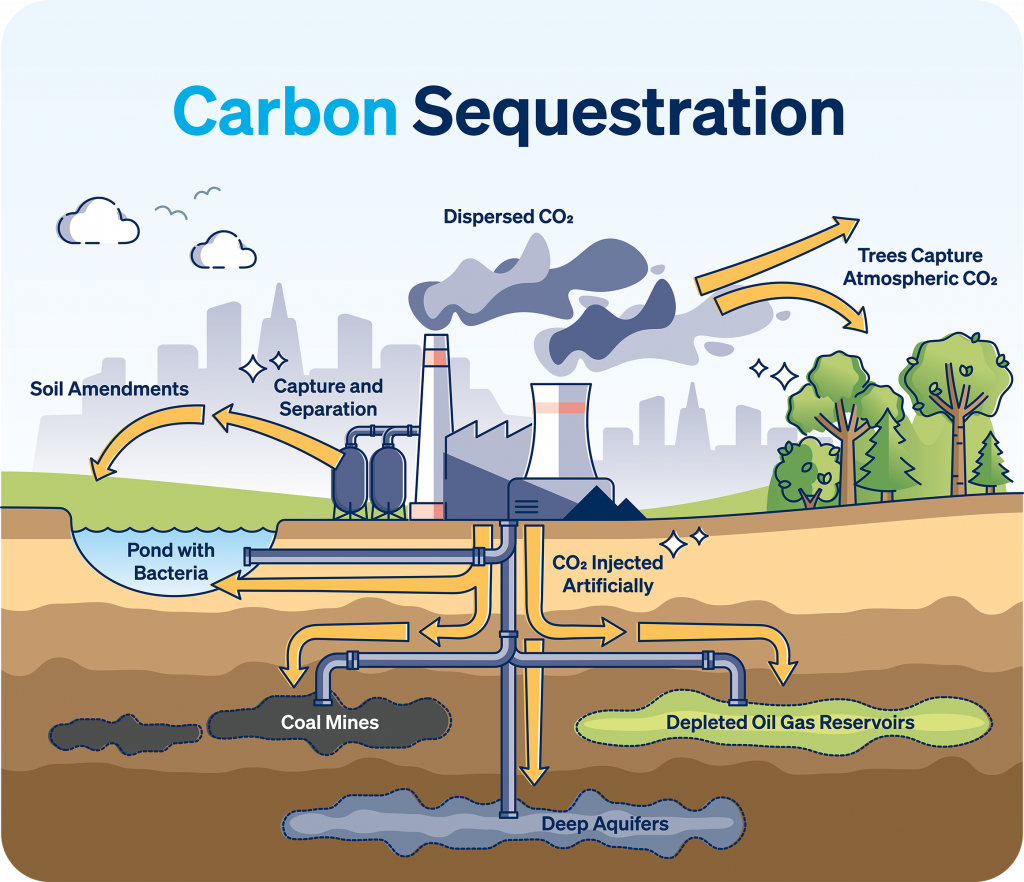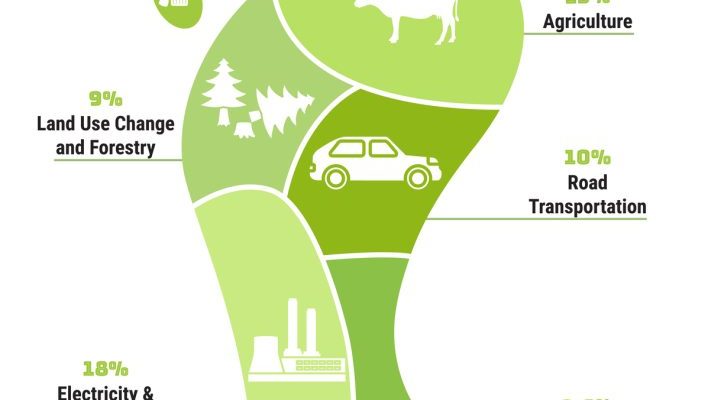When we talk about the impact we have on our environment, one term that often comes up is ‘carbon footprint’. But what does this really mean? A carbon footprint measures how much we affect the Earth, particularly in terms of the gases we release into the atmosphere. These gases, primarily carbon dioxide and methane, are mainly produced by our daily activities – like driving cars, using electricity, and even the food we eat.
Our carbon footprint is crucial because it ties directly to some of the biggest environmental challenges we face today, such as climate change and global warming. By learning about carbon footprints, we become more aware of our personal impact on the planet and can make better choices to protect our environment.
Table of Contents
What is a Carbon Footprint?
A Simple Definition
A carbon footprint is the total amount of greenhouse gases that are emitted into the atmosphere as a result of our actions. These gases, mainly carbon dioxide (CO2) and methane (CH4), trap heat in the Earth’s atmosphere, leading to a warming effect known as the greenhouse effect.
Greenhouse Gases Explained
So, what are these greenhouse gases? Carbon dioxide is the most common one, produced whenever we burn fossil fuels like coal, oil, and natural gas. This happens in various activities, from driving cars to producing electricity in power plants. Methane, another significant greenhouse gas, is released during the production and transport of coal, oil, and natural gas. It’s also emitted by livestock and other agricultural practices.
The Link to Global Warming
These greenhouse gases are like a blanket around our planet. When their levels increase, they trap more heat from the sun, leading to a rise in Earth’s average temperature. This process is known as global warming. It leads to various environmental issues like melting glaciers, rising sea levels, extreme weather events, and changes in wildlife habitats. By understanding our carbon footprint, we start to see how our everyday actions contribute to these larger global challenges.
Also Check – Global Warming and Climate Change- Pioneering Solutions for a Sustainable Future
The Origin of the Term “Carbon Footprint”
Historical Context and Evolution
The term ‘carbon footprint’ has become a key part of our environmental vocabulary, but where did it come from? It evolved from the concept of ‘ecological footprint’, introduced in the early 1990s by Canadian ecologist William Rees and Swiss-born regional planner Mathis Wackernagel. This earlier term measured how much land and water area a human population needed to produce the resources it consumed and to absorb its waste, under prevailing technology.
The ‘carbon footprint’ concept focuses more specifically on the impact of greenhouse gases that result from our activities. It’s a more recent way to understand and communicate the environmental impact we have, particularly in relation to climate change.
Linkage to the Broader Concept of Ecological Footprint
While an ecological footprint includes various aspects like land and water use, a carbon footprint zeroes in on the emissions of greenhouse gases. These gases, notably carbon dioxide and methane, are significant contributors to the greenhouse effect and global warming. By understanding our carbon footprint, we gain insight into one of the most critical aspects of our broader ecological impact.
Everyday Examples of Carbon Footprints

Activities Contributing to Carbon Footprint
Every day, without even realizing it, we contribute to our carbon footprint through various activities. For instance, when we drive a car, the engine burns fuel, which creates carbon dioxide. The electricity that powers our homes, if it comes from burning fossil fuels like coal or natural gas, also adds to our carbon footprint. Even simpler actions, like using a hairdryer or watching TV, contribute to this footprint when they rely on electricity generated from fossil fuels.
Direct and Indirect Contributions
There are two ways we contribute to our carbon footprint: directly and indirectly. Direct contributions come from things we do or control, like driving a car or heating our homes. Indirect contributions are a bit harder to see. They come from the production and transport of the goods we use. For example, the manufacturing of a smartphone or the shipping of food from faraway places adds to our carbon footprint, even though these processes happen out of our sight.
Why Carbon Footprints Matter
Impact on Global Climate
Carbon footprints are not just numbers; they have real effects on our planet. The gases that make up our carbon footprint, especially carbon dioxide and methane, are major players in global warming. When these gases accumulate in the atmosphere, they trap heat from the sun, causing the Earth’s temperature to rise. This leads to climate change, which can result in more extreme weather, melting polar ice, rising sea levels, and disruption of natural habitats.
Differences Among Countries and Individuals
Not everyone’s carbon footprint is the same. Developed countries, like the United States, tend to have much larger carbon footprints per person compared to developing countries. This difference is due to higher consumption rates and reliance on fossil fuels in wealthier countries. Even within countries, there can be significant variations among individuals based on lifestyle, economic status, and personal choices.
Long-term Effects
The choices we make today regarding our carbon footprint have long-lasting effects on our planet and future generations. A larger carbon footprint contributes more to global warming, posing risks like environmental degradation, loss of biodiversity, and challenges to human health and resources. Reducing our carbon footprint can help slow down climate change and protect the planet for future generations.
Also Check – Essays on Save Earth- 3 Diverse Approaches to Environmental Preservation
Measuring Carbon Footprints
How Carbon Footprints Are Calculated
Calculating a carbon footprint involves adding up the total greenhouse gas emissions caused by an individual, organization, event, or product. This calculation often considers various activities, such as energy use, transportation, and consumption habits. These emissions are usually measured in units of carbon dioxide equivalents (CO2e) to account for the different impacts of various gases.
Primary and Secondary Carbon Footprints
There are two parts to a carbon footprint: primary and secondary. The primary footprint is the direct emissions from our activities, like driving a car or using electricity in our homes. The secondary footprint comes from the lifecycle of products we use – from the manufacturing and transportation of goods to their eventual disposal. For example, the food we eat has a carbon footprint that includes the emissions from farming, processing, transporting, and even disposing of it.
Reducing Our Carbon Footprint

Practical Steps Individuals Can Take
Reducing our carbon footprint is not just good for the planet; it’s a responsibility we all share. Simple actions can make a big difference. For instance, using less energy at home, like turning off lights when not in use or choosing energy-efficient appliances, helps reduce emissions. Recycling and reusing materials also play a significant role in cutting down waste and energy consumption.
Diet and Transportation Choices
What we eat and how we travel have major impacts on our carbon footprint. Eating more plant-based foods and less meat can significantly reduce emissions, as meat production is a high emitter of greenhouse gases. Similarly, choosing public transportation, biking, walking, or even carpooling instead of driving alone can greatly reduce the emissions from our daily commutes.
The Importance of Collective Action and Policy Changes
Individual actions are important, but larger changes often require collective effort and policy changes. Supporting policies that encourage renewable energy, sustainable agriculture, and green transportation can lead to significant reductions in carbon emissions. When communities, businesses, and governments work together, the impact can be substantial and long-lasting.
The Bigger Picture
Global Shift to a Low-Carbon Economy
To effectively tackle climate change, a global shift towards a low-carbon economy is essential. This means moving away from fossil fuels to renewable energy sources like solar, wind, and hydro power. A low-carbon economy not only reduces greenhouse gas emissions but also leads to sustainable growth and innovation.
Role of Natural Environments in Carbon Sequestration

Natural environments like forests, oceans, and wetlands play a crucial role in absorbing carbon dioxide from the atmosphere, a process known as carbon sequestration. Protecting and restoring these natural environments are critical in balancing our carbon emissions. For example, planting trees, preserving mangroves, and restoring wetlands can significantly increase the Earth’s capacity to absorb carbon dioxide.
Future Challenges and the Path Forward
Looking ahead, the challenge is not just reducing emissions but also adapting to the changes already underway due to climate change. This will require innovative solutions, international cooperation, and a commitment to sustainable development. By understanding and acting on our carbon footprint, we can make a positive impact on our planet’s future.
In this article, we have explored the concept of carbon footprint, a crucial measure of our impact on the environment. From understanding what it means, to recognizing our personal and collective roles in reducing it, we’ve seen how our everyday choices affect the planet. Carbon footprints matter because they are directly linked to climate change, a global challenge that affects us all.
Reducing our carbon footprint is not just an individual effort; it requires global cooperation and changes in policies and lifestyles. Whether it’s through energy conservation, making sustainable transportation and diet choices, or supporting environmental policies, every action counts. By being mindful of our carbon footprint, we can contribute to a healthier, more sustainable world for ourselves and future generations.
Remember, every small step towards reducing our carbon footprint can lead to significant positive changes for our planet. Let’s all strive to be part of the solution in creating a better, more sustainable future.
Also Check – Essay of Soil Pollution
Also Check – Essay on Air Pollution
Also Check – Essay on Air Pollution in India- Current Challenges and Future Strategies



